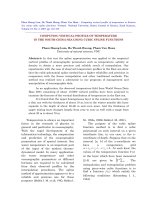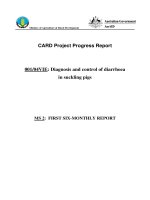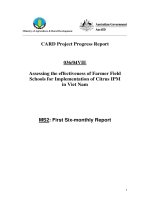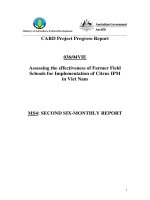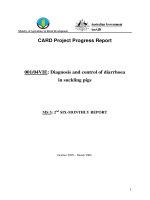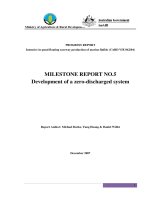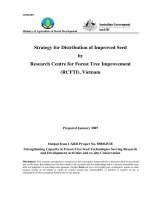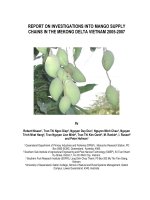Báo cáo nghiên cứu khoa học " COMPARATIVE GROWTH PERFORMANCE OF COMMON CARP STRAINS IN UPLAND SMALL SCALE AQUACULTURE " pdf
Bạn đang xem bản rút gọn của tài liệu. Xem và tải ngay bản đầy đủ của tài liệu tại đây (5.22 MB, 6 trang )
Collaboration for Agriculture and Rural Development
(CARD)
Program
26
COMPARATIVE GROWTH PERFORMANCE OF COMMON CARP
STRAINS IN UPLAND SMALL SCALE AQUACULTURE
Project title:
Better Breeds of Common carp (
Cyprinus carpio
L.) for Small
-
scale Fish Farmers
Project c
ode
:
CARD
002/0
4 VIE
Author(s):
Pham Anh Tuan
1
, Le Quang Hung
1
and Christopher M Austin
2
Project Implementing organisations:
1
Research Institute for Aquaculture No 1, Bac Ninh, Vietnam
2
School of Science and Primary Industries, Charles Darwin University, Australia
S
UMMARY
This paper presents on
-
farm trail on comparative growth performance of four strains of Common carp
i.e.
the selected strain H3B, newly introduced from Hungary HP3, Vietnamese Wild Carp VNW and a
locally
available strain LOC in
small
-
scale ponds and
rice fields in Yen Bai and Thai Nguyen
province. HP3 has shown better growth than that of H3B, VNW and LOC. The differences in growth
between strains varied from farms to farms and relating to level of feeding. Based on result of this
trial, relevant strai
n of common carp was recommended for upland fish producers
1.
Introduction
Common carp is one of the most popular
freshwater aquaculture species in Vietnam and
is cultured in pond, and rice field for
household consumption and income
generation. The lev
el of culture intensity for
common carp varies from small scale
extensive farming, with fish deriving all their
nutrition from natural pond productivity,
through semi
-
intensive farming using
fertilization from organic material such as
bran, agriculture by
-
products and household
wastes to high intensive culture system with
high stocking densities and the use of
manufactured fish foods. Semi
-
intensive
culture systems are the most popular in
Vietnam using ponds or a combination of
ponds and rice field cultivat
ion
(Austin et al.,
2007)
.
In Vietnam there are many different local
varieties of common carp that have been used
by farmers but they usually have small size
and low growth rate
(Thie
n, 1983)
. Over recent
times the Research Institute for Aquaculture
No.1 (RIA
-
I) has bred genetically improved
common carp strains to enhance the
productivity of small scale fish farms that
utilise this species. This program has used
crossbreeding and mass
and family selection
methodologies to produce genetically
improved strains and is considered to have
achieved an average increase of 5% in growth
rate per generation over a number of
generations
(Thien and Thang, 1992)
.
However, all the selective breeding and
associated growth trials have been conducted
in research ponds, often without the
availability of unselec
ted lines as control
populations for comparative studies.
As a consequence, on
-
farm growth trials of
different strains were undertaken to allow for a
more effective analysis of carp growth under
environments directly relevant to small scale
carp farmers a
nd as a strategy to encourage
uptake by farmers of genetically improved
strains. This report presents, firstly, a report on
the statistical analysis of growth of different
common carp strains in small scale farmer
ponds in Yen Bai and Thai Nguyen provinces
.
The farmers participating in this research
project included those using both pond and rice
field culture from mostly highland
environments.
CARD 002/04 VIE
–
B
etter Common Carp Breeds for
F
armers
27
2.
Research contents and methods
2.1.
Experimental Design
The experiment were scaled up to include 40
separ
ate farmers and four strains. The majority
(34) of farmers used ponds as their culture
systems with six farmers using rice field
systems, which reflects the proportion of these
different farming systems in these provinces
based on the socio
-
economic survey
. Farms
were classified according to their levels of feed
inputs as either high or low to determine if this
important management aspect influenced the
relative performance of the different carp
strains. Farmers who did not provide food
more than once per m
onth were classified as
having “Low” input pond systems and those
who fed at least once per week or more
frequently were classified as having “High”
input pond systems. The experiment was
conducted over a 12 months period from
March 2006 to March 2007 in T
hai
Nguyen
and Yen Bai provinces.
Fours common carp strains were used for
growth trials and included HP3 recently
imported from Hungarian carp, H3B selected
strain,
VNW an unselected Vietnamese strain
and a locally available strain LOC produced
from bro
odstock available from the Yen Bai
provincial hatchery.
Broodstock of each experimental strain were
induced to breed on the same day, using
standard practices for gamete stripping and
fertilization. Between 10
-
12 families of fish
were obtained from eac
h strain. After
fertilization eggs produced from different
families of the one strain were pooled and
raised in 200l upwelling incubators. After 4
-
5
days when larvae had reached 8
-
12 mm they
were transferred to four ponds and stocked at a
rate of 100 larva
e/m
2
and grown for a period of
two months. Every effort was made to keep the
conditions under which the fry and fingerlings
of each strain were raised as similar as
possible, especially in relation to stocking
density and feeding regime. When the
fingerlin
gs had reached of 3
-
5g, they were
tagged by using Coded Wire Tag (CWT). The
strains of common carp lines were marked by
placing the CWTs on different locations on the
body. The tagged fish were stocked into 40
ponds or pond
-
rice field systems over a two
da
y period. Communally stocked fish were in
equal proportions of fingerlings. Each farm
pond or rice field was stocked at a rate of 0.3
fish/m
2
and was classified as either “Low
Feed” or “High Feed” based on the level of
food inputs into the ponds. Rice fiel
d systems
fed less than once per week were classified as
low input systems and more than once per
week as high input.
An experimental pond
Experimental rice field
All experimental ponds and rice fish fields
were managed by farmers. Fish in ponds and
rice fields were fed by available foods from
farmers’ households such as rice bran, corn
and cassava. A log book was provided to each
farmer to keep a record of food inputs into
their experimental pond and other relevant
information.
Pham Anh Tuan, Le Quang Hung & Christopher M Austin
28
2.2
Data collectio
n and analysis
Fish were harvesting by draining and by
netting. Data from were collected as fish wet
weight to the nearest 0.1 g and length (snout
–
caudal) measured to the nearest mm . Fish
were allocated to strain based on the
identification of the posi
tion of the CWT using
a detector scanner (North West Marine
technology, Shaw Island, WA, American). To
compare growth between strains, fish weights
were converted to daily growth rate (DGR)
after first subtracting the mean fingerling
weight for that strain
.
Percentage of recovered fish and harvested fish
biomass of each common carp strain were
analyzed as ANOVA. All analyses were
conducted using the Excel and SPSS software
packages.
3.
R
esults and discussions
3.1
Growth and survival of HP3 and LOC
st
rains and effects of feed input
Growth rate for the HP3 and LOC strains were
compared in 18 farms which included both low
and high feed input systems. Significant
differences were observed for all factors and
for the interaction between production systems
and strain (Table 1) (P<0.01). The mean daily
growth rate of HP3 strain (0.48g) was 60%
higher than that of local strain (LOC) (0.30g).
Daily growth rate of each fish farm is present
in Fig 1.
Table 1.
Daily growth rate of HP3 and LOC
common carp strain
in two type of feeding
regimes
Strain
Low
High
HP3
0.22 ± 0.02
a
1.13 ± 0.03
c
LOC
0.16 ± 0.02
b
0.79 ± 0.04
d
Feed input
This last finding is particularly significant as it
indicates that while there is a significant
difference among strains, this difference is
greatly diminished in production systems with
low feed inputs. The average daily
growth rate
for the 2 strains is only a 0.06g difference in
average daily growth in low feed input systems
compared with a 0.36 in high input system.
0.00
0.50
1.00
1.50
2.00
2.50
3.00
Luat
Ha
Ke
Vinh
Tuan
Lieu
Dieu
Que
Lich
Lien
Hom
Nhan
Thong
Thuan
Truong
Hoan
Tap
Chung
Farm
DRG (g)
HP3
LOC
Low feeding rate
High feeding rate
Fig
1
.
Daily growth rate of HP3 and LOC common carp strains
The result
s from an analysis of survival rate of
two strains are shown in Table 2. There is a
significant difference in survival rate between
low and high feed input farms but no
significant difference between strains. The
survival rate of HP3 and LOC strains is
24
.77% and 22.76% respectively and it is 62%
higher in High feed input ponds compared to
Low feed input ponds.
CARD 002/04 VIE
–
B
etter Common Carp Breeds for
F
armers
29
Table 2.
Survival rate of HP3 and LOC
common carp strains grown with two types of
feeding rates
Feedinput
N
Mean
Std
Min
Max
Low
28
21.29
a
0.86
11.72
29.33
High
8
32.44
b
6.31
14.17
62.00
Total
36
26.90
a
3.58
12.95
45.67
3.
2
Growth rate and survival of HP3,
H3B a
nd LOC strains
Growth data from three strains, HP3, H3B and
LOC were compared in 11 farms which
included 10 low and 1 high feed input systems.
Significant differences were observed for
strain and farmer as presented Table 3. The
effect of the level of fe
ed input could not be
tested statistically due lack of replicates. The
differences between strains can be seen from
Figure 2 and Table 3 The daily growth rate of
common carp in each farm is presented in Fig
3. Each strain was significantly different on the
basis of Tukey’s test with HP3>H3B>LOC.
Table
0
.
Daily growth rate of HP3, H3B and
LOC strains grown in Yen Bai and Thai
Nguyen
Strain
N
Mean
Std
Min
Max
HP3
301
0.33
a
0.34
0.05
1.90
H3B
282
0.26
b
0.27
0.04
1.51
LOC
256
0.23
c
0.23
0.02
1.05
Total
839
0.27
d
0.28
0.03
1.49
Fig
2
.
Example of relative growth of three
strains of common carp in rice
field in Yen Bai
0.000
0.200
0.400
0.600
0.800
1.000
1.200
1.400
Luat
Ha
Vinh
Tuan
Lieu
Que
Lien
Hoan
Nhan
Thuan
Thong
Farm
D R G ( g )
HP3
H3B
LOC
Fig
0
.
Daily growth rate of HP3, H3B and
LOC common carp strain in Yen Bai and Thai
Nguyen
ANOVA analyses of survival rate of common
carp showed that there was a significant
difference between farms, while survival r
ate
between common carp strains was not different
. The average survival rate of HP3, H3B and
LOC was 24.28%, 25.78%, and 23.45%
respectively.
3.
3
Growth rate and survival for HP3,
VNW and LOC Strains
Growth data from three strains, HP3, VNW
and LOC we
re compared in 5 farms which
included 4 low and 1 high feed input systems.
Significant differences were observed for both
strain and farmer factors as presented Figure 4.
While the effect of production system could
not be tested statistically due to lack o
f
replicates for this effect and the differences
between strains and farms can be seen from
Figure 4. Each strain was significantly
different on the basis of Tukey’s test with
HP3>VNW>LOC.
The results of the survival rate of three
common carp strains (HP3
, VNW and LOC)
showed no significant differences between
farms. Although survival rate of HP3 was the
highest (20.57%) there had no significant
difference comparing with other two strains
(VNW = 17.98% and LOC = 18.49%).
Pham Anh Tuan, Le Quang Hung & Christopher M Austin
30
0.00
0.10
0.20
0.30
0.40
0.50
0.60
Ha
Lien
Hom
Nhan
Chung
Farm
D R G (g )
HP3
VNW
LOC
Fig 4.
Daily growth rate of HP3,
VNW and
LOC common carp strain in Yen Bai and Thai
Nguyen
3.
4
Growth rate and survival of HP3,
H3B, VNW and LOC strains in low
feed input
Growth data from all four strains, HP3, H3B,
VNW and LOC were compared in 3 low input
farms in which they were rai
sed communally.
Significant differences were observed for both
strain and farmer. Post hoc tests indicated
significant differences among strains with HP3
> H3B = VIET > LOC. Daily growth rate of
each strain and farm are presented in Fig 5.
0.00
0.05
0.10
0.15
0.20
0.25
0.30
0.35
0.40
Lien
Ha
Nhan
Farm
D R G ( g )
HP3
H3B
VNW
LOC
Fig.5.
Dail
y growth rate of HP3, H3B, VNW
and LOC common carp strains
.
The results of survival rate comparisons
among four common carp
strains (HP3, H3B,
VNW and LOC)
. There are significant
differences between fish survival rate among
farms (P<0.05) with survival ra
te of fish in the
farms ranged from 20.94 to 16.81 %. There
was no significant differences in survival rate
between common carp strains (P>0.05).
4.
Conclusions and recommendation
s
4.1
Conclusions
Significant differences in growth rate of
common carp
strains were found. The growth
rate of the HP3 strain was superior to the H3B
and VNW strains, which in turn were superior
to the local strain (LOC). At the extremes the
difference between the worst strains and best
strains was 44%.
In low input systems
the average differences
between the best and worst strains was a
growth rate of 0.06 grams per day, where as in
high input systems the average difference in
growth rate was 0.34 grams per day.
Very large difference in growth, survival and
biomass product
ion were apparent between
farms. The
difference in daily growth rate
between farms was much greater than between
strains. The best performing farm had from a
31 and 12.6 fold difference in growth rate for
the LOC and HP3 strains respectively. A
significant
factor explaining these differences
can be attributed to feed input but it is likely
that other environmental and husbandry
aspects contribute to these very substantial
differences.
Acknowledgement
Many people contributed to the success of the
on
-
farm t
rail to compare growth performance
of common carp strains conduced in farmers’
ponds and rice fields in Thai Nguyen and Yen
Bai province as part of CARD project
002/04VIE. The project was given significant
support from the Provincial Fisheries Centers
of T
hai Nguyen and Yen Bai. The efforts and
assistance of the 40 common carp farmers
who participated in these trials is gratefully
acknowledged.
CARD 002/04 VIE
–
B
etter Common Carp Breeds for
F
armers
31
Reference
s
1.
Austin, C. M., A. Pham, T., B. T. Thai
and Q. H. Le. 2007a. Fish breeding
pract
ices and stock improvement
strategies in Vietnam in relation to
common carp. 112.
2.
Thai T.B., C. P. Burridge and C. M.
Austin. 2007. Genetic diversity of
common carp (Cyprinus carpio L.) in
Vietnam using four microsatellite loci.
Aquaculture 269: 174
-
186.
3.
T
hai, B. T., A. T. Pham and C. M. Austin.
2006. Genetic diversity of common carp
in Vietnam using direct sequencing and
SSCP analysis of the mitochondrial DNA
control region. Aquaculture 258: 228
-
240.
4.
Thai, T. B. and G. T. Ngo. 2004. Use of
pineapple juice
for elumination of egg
stickiness of common carp (
Cyprinus
carpio
L.). Asian Fisheries Science 17:
159
-
162.
5.
Tran Mai Thien. and Nguyen Cong
Thang. 1992. Selection of common carp
(
Cyprinus carpio
, L) in Vietnam.
Selection of research works (1988
-
1992). Ag
riculture Publisher House,
Hanoi (
In Vietnamese
).
6.
Tran Dinh Trong, 1983. A contribution to
morphological mutation of common carp
(
Cyprinus carpio
L.) in Vietnam, A
contribution to morphological mutation of
common carp (
Cyprinus carpio
L.) in
Vietnam. Pedag
ogical University (in
Vietnam), Hanoi.
